

First Friday Letter
The World Methodist Council
Greetings from the General Secretary!
“We love because God first loved us. Those who say, “I love God,” and hate others, are liars… those who love God must love their brothers and sisters also. (1 John 4:19-21)
Dear reader,
The present time is full of fear and hate. Love beckons a chance in the midst of war and polarisation. As Rabbi Dr Frank puts it (see article pg 6): “it is time for an unprecedented level of collaboration, grassroots dialogue and practical aid.” Find examples of such approach that seeks simple and practical consequences on the articles in this FFL, e.g.: the conversation with the Salvation Army, the plans for continuing the path to unity paved by the Joint Declaration on the Doctrine of Justification, and a testimony of a Mexican presbyter.
I present to you the 2025 February First Friday Letter dealing in faith and hope with issues that require “love to be upon the throne”, as John Wesley preached (Sermon 92 - on Zeal). This was in the past even more now, in times of high mobility and encounter between different cultures, religions, languages through migration.
Paddington Bear is an adventurous migrant from darkest Peru to England. His life has been quite disastrous. But by a stroke of luck, he makes it. Though he wears different clothes and speaks in a funny way, he finds a generous family that welcomes him into their own home giving him sanctuary. In a short period of time the Browns become very conscious of how different he is. However, Mr Brown says that ‘in London, everyone is different and that means anyone can fit in.’ Recently, the Office for National Statistics UK published figures showing that in London over a third of the current population was born abroad. London, where most immigrants settle, is the most productive part of Britain.
The Browns could be a parable of blessedness: blessed are the people who love those who a different. Happy are those who welcome them. Holy are those who learn from them. Beatified are those who protect them. They don’t judge but accept. They love and in doing so they find themselves in the other. They are on the path to holiness and happiness. I am an immigrant from sunniest Brasil. Like Pad-
February 2025
dington Bear, I love the Browns. I have a suspicion that they might be Methodists: ‘anyone can fit in,’ sounds familiar. In Wesleyan theology anyone can fit because Jesus died for all. Charles Wesley said of God: “universal love Thou art.”
Fear makes us prone to believe in lies about the other, creating monstrous ‘truths’ within, and that feeds fear over and over again exponentially. This vicious circle of hate opposes good relationships. Walls and barriers are erected. They keep the other out as much as they imprison those who fear. For the epistle of John, the way out of this vicious circle is love. Perfect love casts out fear. (1 John 4:18)
Our message is: Love is the way of Christ. One must choose whether to seek perfect love or to be imprisoned by fear and hate. The invitation of the Gospel is for a conversion of the heart towards love. Former WMC President, JC Park, after attending the XVIth Synod of Bishops in Rome, last October, said that for us to walk side by side in the path to unity, we need conversion. Peace calls for a conversion towards the path of love (see David Hardman’s article, page 4). What is at stake is more than land, gold and power but freedom from fear and hate. Hate for the other and war are the same and one thing. Whilst love and peace abide.
In hope Yours


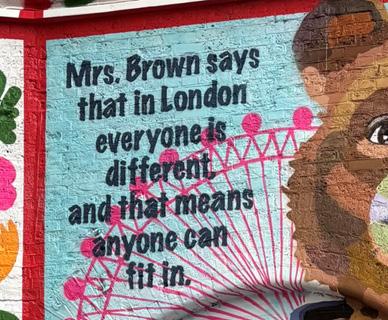
Photo 136007839 © Kabayanmark |
Paddington Bear mural, Waterloo, London
From the General Secretary’s Diary:
Holiness and Happiness
Responding to the Lecture: “The Complete art of Happiness - engaging with Wesley through a Theology of Happiness”, ( see also Paul Chilcote’s article later in this FFL page 3) the General Secretary thanked Rev Dr Julian Purchase for articulating in Wesleyan terms a way of valuing happiness as salvation and as part of the search for holiness.
The lecturer had challenged the audience to a deeper understanding of happiness in God as salvation not only from but more poignantly salvation for and to. Such an understanding of salvation and happiness would lead therefore not to a self-centred and superficial happiness but to a mature and relational happiness with God and with others. He said: how could we explain happiness “that is centred in God, oriented to the telos of perfecting love, and draws us to happy and holy communion?”
In his reply the General Secretary asked the lecturer and those gathered at Wesley House Cambridge for the occasion: how best to translate: ‘Makarioi’? This is Greek New Testament term used by Jesus in the Beatitudes (Matthew 5 and Luke 6) traditionally translated as blessed, and in new translations as happy. The poll showed the audience preferred blessed to happy are they… but the points the lecturer was making: happiness as spiritually mature and relational were not lost as they sang:
“My God, I am thine; What a comfort divine, What a blessing to know that my Jesus is mine! In the heavenly Lamb Thrice happy I am, And my heart it doth dance at the sound of his name.” (Charles Wesley)
- MoU
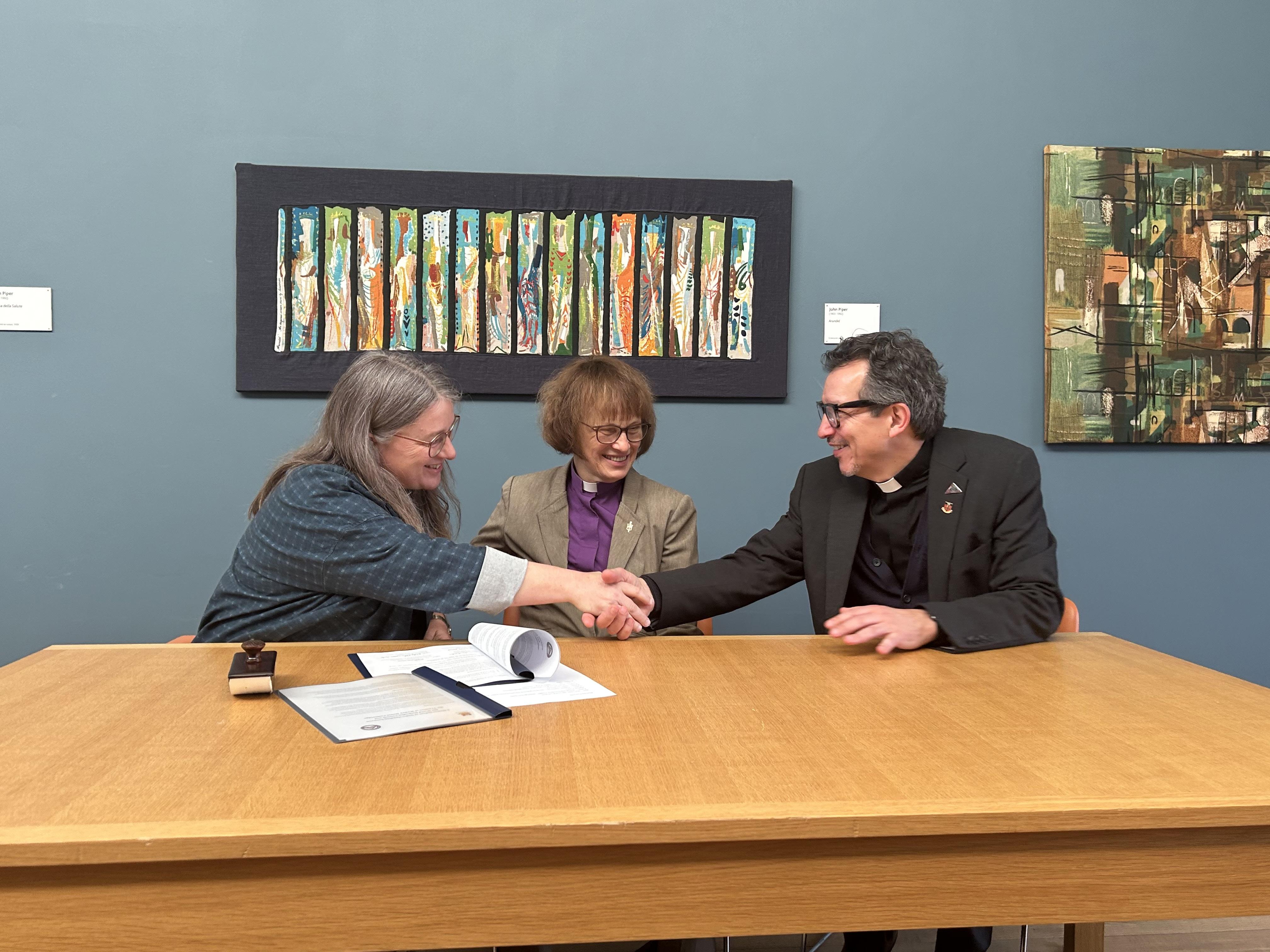
Left to Right, principal of Wesley House the Rev. Dr. Jane Leach, WMC President Bishop Debra Wallace-Padgett and WMC General Secretary the Rev. Dr. Reynaldo Ferreira Leão Neto
The Church’s Role in Building Just Peace
We live in a world that seems to be intent on building walls, dividing people, and consolidating power. Polarization and echo chambers fuel anxiety and sap our world of hope. Over against the momentum of these developments a focus on conversation and collaboration can shift our energy in more produ tive channels in the direction of peace, hope, and love. It is amazing how something so simple as conversation can establish greater unity among people. Likewise, collaboration produces something greater than the sum of its parts.
Methodist and Salvation Army Connections
Wesley House recently hosted a conversation between representatives of the World Methodist Council and The Salvation Army. This was not a new development but the continuation of discussions begun in 2003. The first round of a formal International Dialogue launched in that year consisting of two meetings, the first held at Sunbury Court in Middlesex, the second (2005) at Lake Junaluska, North Carolina. A second round followed the same pattern in 2009 and 2011. I have had the great privilege of being part of this process from the beginning and continue to be energized by this particular iteration of dialogue.
In the first round of conversations we really came to know one another better. Given the fact that William and Catherine Booth founded the Army out of the Methodist New Connexion meant that we shared a common theological perspective and historical origin. Our hope was to strengthen our relationship for the purposes of a united witness and service in the world. The Methodists rediscovered the essential place of mission in the church and Salvationists were reminded about the importance of communities of faith in which disciples of Christ experience formation and growth.
The second round of the Dialogue concluded with a report entitled “Working Together in Mission: Witness, Education and Service.” At this point, our hope was that conversation would move more directly into collaboration. This report was unique among the various documents produced from other Dialogues in the inclusion of many stories from around the world that illustrated the ways in which collaboration in the three areas of life celebrated God’s mission.
Ongoing Conversation
The most recent conversations held at Wesley House, 13-15 December, were not part of a formal Dialogue, but were an important “touch point” in this ongoing journey. Six participants reflected on
the theme ‘To serve the present age, my calling to fulfill, O may it all my powers engage to do my Ma ter’s will’. This quote from a Charles Wesley hymn helped frame a more extended reflection on the three sub-themes: witness, education, and mission. Guiding questions conjoined conversation with collaboration:
• Since the last round of talks, what has changed in our world?
• What examples of witness do we have that are being fruitful for God’s kingdom?
• How can we be learning from one another?
• How can we encourage mutually supportive ministry?
Brian Beck Memorial Lecture
Those who designed the conversation process i corporated a very special event in the flow of the conference, expanding the conversation and audience. The Revd Dr Julian Pursehouse presented the inaugural Brian Beck Memorial Lecture, addressing the theme: The Complete Art of Happiness - Engaging with Wesley through a Theology of Happiness. Given the fact that holiness was a theme running through the lives of John and Charles Wesley and that the Salvation Army was birthed as part of the Holiness Movement of the 19 th Century, this proved to be a fitting confluence of important streams. The General Secretary of the World Met odist Council, the Revd Dr Leao Neto and General Lyndon Buckingham of the Salvation Amry gave responses. Bishop Debra Wallace-Padgett, President of World Methodist Council, attended and welcomed the community.
Memorandum of Understanding
The World Methodist Council and Wesley House have collaborated in recent years, Together, they have sought to promote the flourishing of the church and the world through a shared commitment to Wesleyan identity, decolonizing intercultural connexionalism, and ecumenical partnership. Those present at the Beck Lecture also witnessed a fresh expression of this collaborative work. The Rev Dr Jane Leach, Principal of Wesley House and the two WMC officials signed A Memorandum of Understanding between the World Methodist Council and Wesley House Cambridge. This agreement seeks to progress a number of collaborative efforts including Leadership Development, Reflective Pastoral Supervision, Ecumenical collaboration, Public Theology, and Global Wesleyan Theology. In particular, they will continue to explore how to encourage conversation between worldwide Wesleyan theological voices.
The Church’s Role in Building Just Peace
The Witness of Conversation and Collaboration
The world is watching. At a time in which many outside the life of the church view Christians as judgmental and arrogant, conversation and collaboration reflect the true spirit of Christ. These simple practices represent an alternative to the rancorous and divisive spirit of our age. They bear witness to the life and ministry of Jesus Christ whom we celebrate at this time of the year in particular as the Prince of Peace. Wesley House continues to be a beacon of light and hope in a world often dark and despairing.
There are many opportunities for you to engage in conversation with others in the hopes of knowing one another better. Conversation facilitates the
transformation of hostility into hospitality. In opposition to the spirit of competition that frequently consumes our lives, collaboration opens doors to the creation of new relationships, fresh ideas, and revitalized faith. As Charles Wesley sang:
Help us to build each other up, Our little stock improve; Increase our faith, confirm our hope, And perfect us in love.
Paul W Chilcote, PhD Research Fellow, Wesley House, Cambridge
Text reproduced with permission from the Methodist Recorder
What Makes for Peace in the Holy Land?
The announcement of the ceasefire in Gaza was met with joy, relief and anticipation in Palestine, Israel and across the globe. The images that we have witnessed since the agreement came into force have produced different emotions, hopefulness at seeing hostages reunited with families compared with the despair at the images of destruction, injury and death from Gaza.
We rightly give thanks for this ceasefire, although long overdue, it brings the promise of an end to the death and destruction that has been meted out on Gaza and the Palestinian people and also the optimism of hostages being freed. However, this on its own does not make for peace in the land we call holy.
I met with many West Bank Christians in Dec 2024 and there was a common theme to our conversations: a belief and a relief that there would be a ceasefire soon but also a dread that 2025 would be a bad year for the West Bank. During the last 15 months as the world has focused on Gaza the situation in the West Bank has worsened with extra restrictions on movement, increased Settler violence and loss of Palestinian land1 and the decimation of the tourist trade that is causing such economic hardship in places like Bethlehem.
Yet, the worry was that this would get worse once a ceasefire was in place and that concern seems well founded. For example, in the first week of the ceasefire Israel have erected 89 gates around Bethlehem that have cut off roads and are forcing residents through a handful of checkpoints. The Israel Defence Forces (IDF) at these checkpoints are
carrying out more thorough checks leading to long tailbacks and making travel around the West Bank increasingly difficult for Palestinians. This is the story for other Palestinians Towns and Cities in the West Bank.
This week Israel announced the Iron Wall offensive in Jenin, a city (including a refugee camp) that is used to IDF incursions but which has also suffered from drone and aircraft missile strikes in the past year. It remains to be seen how long this offensive will last, but the fears of those people who said to me ‘they (Israel) will do what they have done in Gaza in the West Bank’ may well be being realised. An Israel senior security official stated as the Iron Wall operation began: “We are about to launch a large-scale operation in the northern West Bank, which may take months, and at the end of it, the “terror” camps will cease to exist - what we did in Gaza, we will do to it as well, and we will leave it in ruins.”2
News articles over the past 15 months have constantly made reference to Oct 7th as the catalyst to the current situation in Israel Palestine but it is dangerous to ignore any history before this date. A ceasefire in Gaza will not make for peace when there is a long history that has lead us to this point. Gaza was occupied from 1967 and then blockaded from 2007. The West Bank has been occupied since 1967 and Palestine has constantly lost land since the UN partition plan of 1947.
Continued on page 5
What Makes for Peace in the Holy Land?
War, violence, aggression, occupation and oppression have not made for peace. There are a generation of people in the region who have grown up without seeing a hope of a political solution, without this hope some turn to violence and see taking up arms as the only solution left to them. There is real potential of a significant increase of bloodshed in the West Bank.
So, what will make for peace in the Holy Land? As he was arrested Jesus makes a simple point to Peter, who in his impetuousness wanted to defend Jesus by using violence, ‘those who live by the sword will die by the sword’. The truth is that living by violence leads to death and destruction and not justice, peace or life in all its fullness. Violence is not just seen in combat, there is also violence is in the brutality of oppression. This everyday brutality is seen the concrete wall, house demolitions as a punishment, Administrative Detention (Israel arresting and holding people without charge), severe restriction of movement, settler aggression and government sanctioned illegal settlements. Responding to brutality and violence with violence simply perpetuates and escalates a deadly cycle.
So what will make for peace? A just solution on which peace can flourish and grow. The prophet Isaiah (11:6-9) shares a vision of what makes for peace: the wolf lies with the lamb, the aggressor lives in peace with the prey, in other words the wolf becomes a vegetarian3 and the lamb can trust that they are no longer in danger. Peace is not the starting point but the outcome of a change of heart that enables justice to prevail over oppression and violence. So when we pray, call not for peace but pray for justice that peace may flourish and grow.
I often get asked two questions; what is the solution and what can we do? I do not have an answer to what the solution is but I do believe that Isaiah gives us an insight in to the process. The wolf and lamb must meet in trust and as equals around a table to discuss how they can live in peace together. International involvement should be in facilitating the meeting not on imposing a ‘peace agreement’.
Speaking with people after the atrocities of Oct 7th and as the equally atrocious bombardment of Gaza began I heard several people say ‘the only good that can come out of this is if there is a determined effort to find a lasting solution.’
What can we do? Imagine a united global Wesleyan voice that called on our international leaders to demand an end to violence and oppression and then facilitated the opportunity for a meetings of equals where two people could decide on how they could live so that peace flourishes rather than death and destruction.
Notes:
1) 50 Palestinian Communities wiped off the map due to Settler violence between Oct 23 and Dec 24 Israeli NGO Kerem Navot
2) Israeli Channel 14 Tuesday 21st Jan 2025
3) Thanks to my friend and colleague Revd. Raj Patta for this image
David Hardman Methodist Liaison Officer, Jerusalem
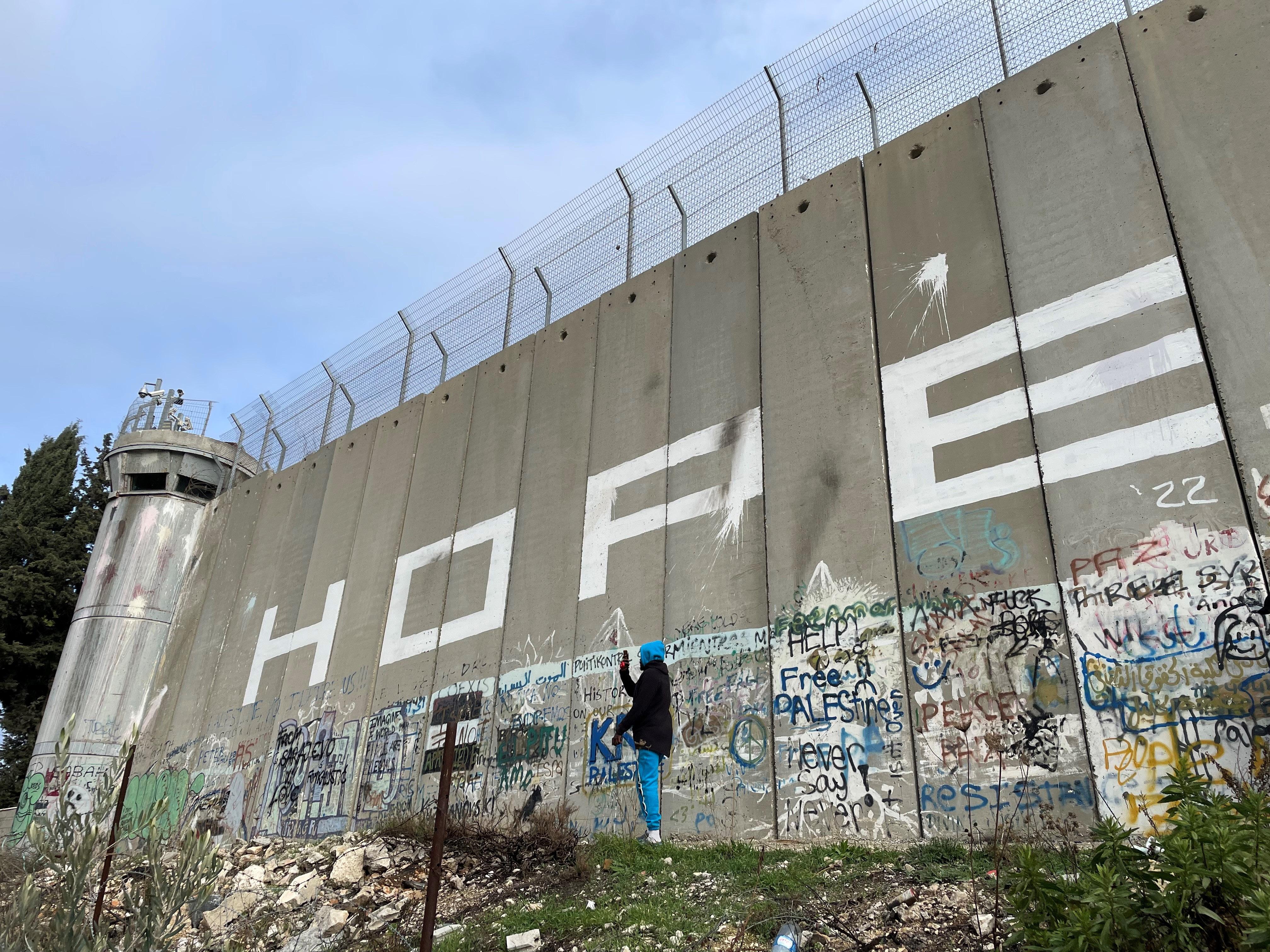
Cease-less Fire
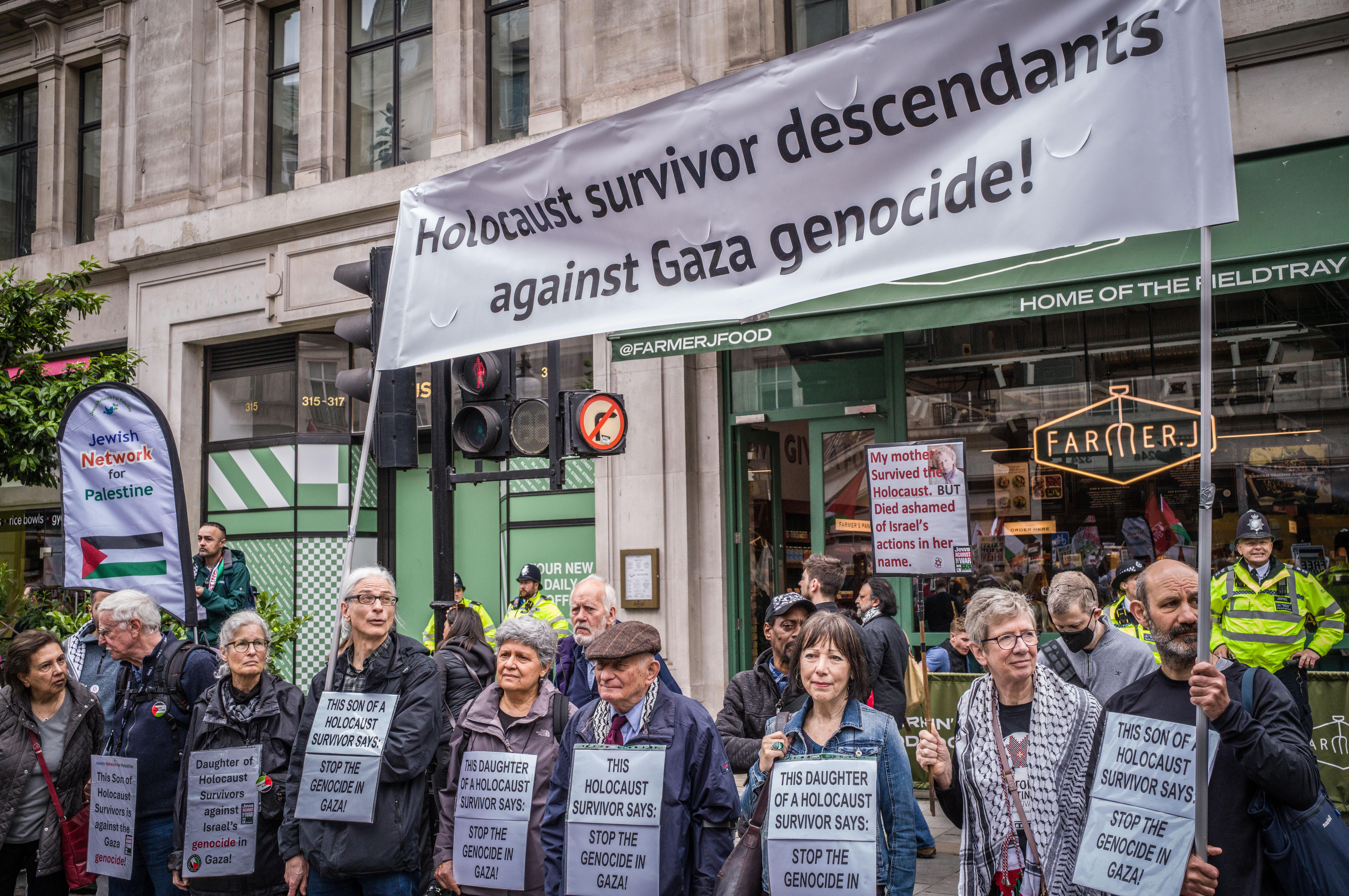
Increasing numbers of Jews, including youth and descendants of Holocaust survivors and refugees, join those demonstrating regularly for a free Palestinian state in London. Photo by Rabbi Dr Frank Dabba-Smith
The terrible killings and kidnappings perpetrated by Hamas on 7th October 2023, while shocking in scale, brutality, and in the ease in which they occurred, were not a surprise to me. As United Nations Secretary General António Guterres stated in his condemnation, these actions ‘did not happen in a vacuum’. 1 Moreover, ‘The Palestinian people have been subjected to 56 years of suffocating occupation’ in which they had ‘…seen their land steadily devoured by settlements and plagued by violence; their economy stifled; their people displaced and their homes demolished’. 2
The Israeli government long thought that Gaza could be controlled effectively by a strategy combining extreme isolation and, when things got out-ofhand, exercising relatively brief but sharp military campaigns referred to as ‘Mowing the Grass’. 3 This time, however, it has emerged that early warnings by both military observers and civilian residents located adjacent to Gaza went unheeded while the ultra-right wing Kahanist-inspired cabinet focused attention on its priority of advancing settlement of the West Bank.
Revenge was swift and in turn unparalleled as Net-
anyahu vowed, in Deuteronomic terms, to ‘blot out the memory of Amalek [i.e.: Hamas] from under heaven’. 4 The biblical trauma of the Children of Israel being harmed on their divinely guided mission to the Land of Israel was being invoked to marshal support by a scandal-ridden and, by this point, ever more unpopular Prime Minister. Such rhetoric also echoed the misused unhealed trauma of the Holocaust, a narrative of unique victimhood, manipulated and psychologically projected onto enemies both non-Jewish and dissenting Jewish voices.
For Israelis and Jews in the Diaspora, self-censorship is the norm with denunciation, threats, and ostracism being outcomes that outspoken opponents risk facing. In essence, either one supports Bibi unequivocally –never mentioning the word ‘occupation’-- or risk being branded a traitorous and self-hating Jew. Within such a McCarthyist political culture, accusing non-Jews of antisemitism also serves to police those within the tribe. Nevertheless, increasing numbers of Jews, including youth and descendants of Holocaust survivors and refugees, join those demonstrating regularly for a free Palestinian state in London, for example.
Continued on next page
After fifteen months of what has included collective punishment waged against civilians on a vastly disproportionate scale, an arguably genocidal activity, Hamas has not been vanquished. Facing opprobrium from Donald Trump –who via Ambassador Mike Huckabee, a right-wing Christian Zionist, advocates Jewish settlement in Gaza and Israeli annexation of the West Bank— Israel finally agreed to cease-fire terms essentially the same as negotiated in May 2024. 5 As Yonaton Mendel has written, ‘That the [Israeli] government took so long to accept it is further proof, if any were needed, that Israeli politicians have no long-term vision, that the government wanted to dilute the chances of forming a state committee of inquiry into the events of October 7, and that its members refuse to prioritize life and futurity over death and endless war.’ 6
So, will the cease-fire hold? Might this somehow be transformed into a pathway for a positive longterm negotiated ‘solution’, such as two-states, each enjoying a semblance of peace and security? Here, I differ somewhat from Yonaton MendeI’s otherwise superb analysis: while Jewish supremacists hold sway in the Israeli government, nothing short of a messianic vision consisting of annexation, ethnic cleansing, full settlement, and the building of a Third Temple on the exact site of the structure destroyed some two-thousand years ago will ultimately suffice. For that long-term vision, Jewish and Christian extremists have already created together the golden implements and have bred the perfect red heifers. Hardly all Israelis support such a scenario as, since October 2023, there has been a sharply increased Exodus of Israelis who can no longer face endless war, right-wing political extremism, and the perceived ruin of the remaining ties that bind their fractured society together. As in other extremist settings, those deemed to be
‘undesirable’ and unable or unwilling to conform or depart will suffer the consequences from the unceasing demands for political, religious, and ethnic purification.
Given the acutely dangerous living conditions in Gaza and the regional political instability, what might be the responsibilities of concerned people, whether Jewish, Christian, Muslim (or any other form of faith or holding no belief in a supernatural being)? I would argue that this is the time for an unprecedented level of side-by-side collaboration for the sake of promoting grassroots dialogue wherever possible and providing practical aid to all those suffering from the consequences of violence. It is also the time for urgently seeking imaginative and yet pragmatic solutions to the macro issues affecting the entire region, such as severe water shortages exacerbated by climate change and environmental toxins resulting from warfare. Within this overarching nightmare, no one will live securely until all are safe.
Rabbi Dr Frank Dabba-Smith
Rabbi Dr Frank, together with Islamic studies teacher Tahseen Mehar and Revd Dr R F Leao Neto presented workshops at the World Methodist Conference that took place in Gothenburg, Sweden, August 2024
1 https://www.bbc.co.uk/news/world-middle-east-67215620 2 Ibid.
3 https://blogs.lse.ac.uk/mec/2018/05/10/mowing-the-grassand-the-force-casualty-tradeoff/
4 https://www.npr.org/2023/11/07/1211133201/ netanyahus-references-to-violent-biblical-passages-raise-alarm-among-critics
5 https://www.nybooks.com/online/2025/01/25/israel-life-bythe-sword/ 6 Ibid.
Nominate a 2025 Peace Award Recipient
If you have been planning to nominate someone who exemplifies Courage, Creativity, and Consistency for the World Methodist Peace Award, please act.
Applications must be submitted by 14 April. Note, all supporting documents must be included.
The nominee should show courage in regard to physical danger or putting personal interest at risk. Creativity should include opening new initiatives and attracting others in working for the cause of peace, Consistency is judged by effort over a period of time and intensity, despite setbacks. Here is the link to read the full criteria: http://worldmethodistcouncil.org/whatwedo/world-methodist-peace-award/
The recipient receives a medallion, citation and US $1000 which is symbolic of the larger recognition achieved in working for peace, justice and reconciliation. The recipient is included in the World Methodist Council Peace award booklet and the photo will be featured on the WMC webpage.
Click here to complete the online application. Please send all nomination forms to the General Secretary at info@worldmethodistcouncil.org.
Register now for Council of Nicaea 1700th Anniversary!
This year marks the 1700th anniversary of the Council of Nicaea, a council of church leaders and others called by the Emperor Constantine to reflect on the being of Jesus Christ. Out of this gathering, and a subsequent gathering at Constantinople in 381AD, emerged one of the great Creeds of the church – the Nicaean- Constantinopolitan Creed.
On three days in March - Monday 3rd; Tuesday 4th; and Tuesday, 18th - the World Methodist Council is organizing three webinars – each one with speakers from two neighboring world regions. Under the title, A Wesleyan Response to Nicaea: Reflections on Faith, Unity and Mission, the speakers will be invited to consider the historical complexity of the 325AD gathering at Nicaea; the Nicene - Constantinopolitan Creed as an agreed statement of faith by Christians of many traditions and denominations; what may be the role, if any, of creeds in the twenty-first century.
Here are the dates and speakers:
March 3 (Focus on Asia-Pacific) 7 am GMT, 3 pm in Manila
Moderator: Revd Dr Seferosa Carroll, United Theological College, North Parramata, Australia
Dr. Te Aroha Rountree, Trinity Methodist Theological College, Auckland, New Zealand
Revd James Bhagwan, Methodist Church in Fiji, General Secretary of the Pacific Conference of Churches
Revd Dr Hermen Shastri, Methodist Church Malaysia, former vice moderator of the WCC Faith and Order Commission
Revd Dr Lisette Tapia Raquel, United Methodist Church, Union Theological Seminary, Manila, Philippines
March 4 (Focus on North and South America) 8 pm GMT, 3 pm EST – Translation to Spanish will be available
Moderator: Revd Prof. Dr. Edgardo Colon-Emeric, United Methodist Church, Duke Divinity School, Durham, NC, USA
Prof. Dr. Blanches de Paula, Methodist Church Brazil, Methodist University Sao Paulo, Brazil
Revd. Dr. Pablo Rubén Andiñach, Methodist Church Argentina, Universidad del Centro Educativo Latinoamericano, Rosario, Argentina
Prof. Dr. Sarah Lancaster, United Methodist Church, Methodist Theological School in Ohio, Columbus, USA
Prof. Dr. Gladson Jothanna, Church of South India, Drew University, Madison, NJ, USA
March 18 (Focus on Europe and Africa) 2 pm GMT, 10 am EDT
Moderator: Revd Dr Martin Mujinga, Methodist Church Zimbabwe, General Secretary of the Africa Methodist Council, based in Accra, Ghana
Revd Jackline Makena, Methodist Church Kenya, St. Paul University, Limuru, Kenia, Vice Moderator of the WCC Faith and Order Commission
Prof. Dr. Simangaliso R. Kumalo, Methodist Church Southern Africa, University of Kwazulu-Natal, Pietermaritzburg, SA
Revd Dr. Jane Leach, Methodist Church Britain, Wesley House, Cambridge
Revd Dr. Sergei Nikolaev, United Methodist Church, Moscow Theological Seminary
Please use the Registration Link for all the meetings and indicate which one you will be able to attend: https://us02web.zoom.us/meeting/register/aWYjeb0zTwuuw_akn2lbyA
You will be receiving the Zoom Link to enter the meeting itself after registration!
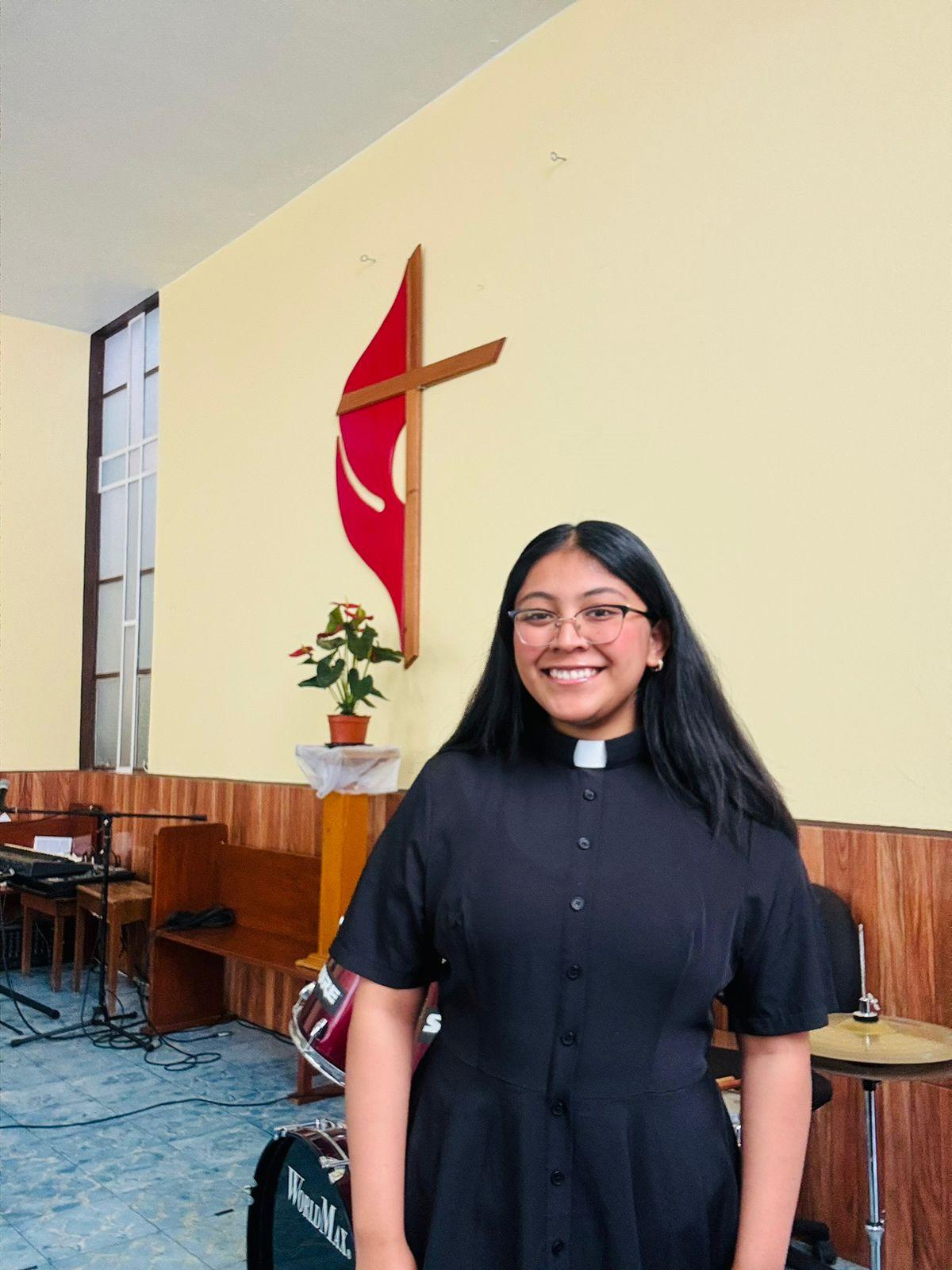
Breaking Barriers: Young Woman’s Journey to Ordination in Mexico
In a country where tradition often dictates the boundaries of possibility, a bright young woman pastor is charting a new course, one step at a time, towards ordination in the Methodist Church of Mexico. At only 21 years old, Keila Limon Serrano is a beacon of hope and perseverance in a society where women in leadership roles face considerable challenges.
Since childhood, she was captivated by the role of pastors, though she noticed that most were men. Nevertheless, she felt an undeniable call to ministry and pursued it with steadfast determination. “Since I was very young, I knew I wanted to be a pastor,” she recalls. At 19, she started serving as a pastor, and two years ago, she began the ordination process, a path rarely taken at such a young age.
Yet, being a woman in ministry in Mexico comes with trials. In one of her appointments, she encountered unexpected resistance. “A church member once told me that for the church’s anniversary, any preacher would be accepted—except a woman,” Keila recalls. “It was sad to hear that, and I had to look for another pastor to come and preach.” Others insisted that only a man could officiate at their wedding, reinforcing entrenched traditions that create additional challenges for women in ministry. While men in pastoral roles are naturally granted respect, Keila and her colleagues must work twice as hard to earn it.
Beyond the church walls, the struggle is even more profound. Mexico remains one of the most dangerous countries for women, with high rates of violence and feminicide. “Heading to church from your home, there is a possibility that you may be attacked,” she explains. Women in the church and society have formed networks of support and protection to provide them with tools to stand firm and navigate both spiritual and social threats. “In Mexico City, for example, subways have carriages reserved only for women, precisely because it is dangerous for harassment. As women, we are also learning how to resolve certain conflicts.”
Encouragingly, there are signs of change. With only two women bishops in Mexico’s Methodist history, recent elections of women in leadership are shifting perceptions. In many congregations, women already form the backbone of church leadership, often filling key roles on church boards. The election of Claudia Sheinbaum as Mexico’s first female President has further reinforced the message that leadership is not defined by gender. “I think it’s important for girls to see that they can also be leaders,” Keila reflects. “We need to ensure that the next generation doesn’t have to fight the same battles we do.”
Despite progress, challenges persist. While women assume leadership roles, young people, in general, remain an elusive demographic for the Church. Although outreach programmes exist, they often struggle to take root. Her congregation, while predominantly women, recognises the need to bridge the gap between faith and young people’s everyday lives. The desire to engage is there; what is needed is the strategy and perseverance to make it a reality.
For Keila, a theology student set to graduate in June 2025 from Seminario Metodista Dr. Gonzalo Báez Camargo, under the leadership of Dean Revd. Basilio F. Herrera López, the dream is clear: to be ordained within the next two years and see more women join in ministry. “I hope that more women will be ordained,” she says. “Children grow up with the image of their pastor, and if they only ever see men, they may think it is the only option.” She envisions a future where young people recognise that their talents—regardless of their professional background—can be dedicated to the service of the Church and the community. Above all, she longs for a day when women no longer have to fight extra battles simply to stand where men have always stood.
Her journey is not hers alone but is shared by countless young women who fearlessly enter spaces historically barred to them. It is a journey of faith, courage and hope, one that bears witness to God’s grace and guidance and reminds us that, even in the face of opposition, change becomes possible.
Stefanie Gabuyo Youth and Young Adult Committee Chair (Co-ordinator), World Methodist Council
JDDJ Celebrates 25th Anniversary
In late January four of us represented the World Methodist Council at a meeting in Strasbourg to celebrate the 25 th anniversary of the Joint Declaration on the Doctrine of Justification by Faith between the Lutheran World Federation and the Roman Catholic Church. The first of three ecumenical partners to do so, the World Methodist Council formally associated itself with this agreement in 2006. The January meeting involved Lutheran, Catholic, Reformed and Methodist theologians learning together about the content, method and reception of the document and asking, what next?
First, we needed to understand the significance of the rift caused between Roman Catholics and Lutherans by the Lutheran confession that justification is by faith alone. This addition of ‘alone’ led to mutual condemnations in the sixteenth century. Condemnations that until 1999 were still in place.
Christian unity has often been represented as a seamless garment like the garment that the soldiers at Jesus’ crucifixion threw lots for rather than tear apart. In Sieger Koder’s image different parts of the church clutch at different pieces, either so self absorbed that they are unaware of each other or in competition, each seeking to justify themselves as the expense of the other. An early flaw in the weaving or knitting of such a garment can produce a serious division in the weave that can eventually unravel the whole.
To repair such a garment, it is necessary to dig through layers to find the dropped stitch. We learned that the process of the JDDJ was such a process, excavating back to understand the misunderstandings of the Reformation period and gradually repairing the breach through a process of differentiating consensus. On each point of difference the Lutherans and the Catholics were able to come to an agreement on a common confession and then spell out the ways in which the doctrine has different significance and meaning within their wider thinking.
For Methodists, with our dual inheritance of the principles of the Protestant Reformation and theology taken from the Eastern theological tradition, some of the points at issue in the Lutheran-Catholic process are not too contentious. We already hold justification and sanctification together, believing that God not only declares right, he also sets right. This intention to make things right is something that Wesley saw in God’s covenant with creation and that points to God’s intention to set things right, especially for the poor and oppressed. For Methodists, what God does in Jesus is in continuity with God’s work in creation and through the prophets and signifies God’s desire for the fulfilment of the whole inhabited earth.
So why should Methodists care about this 25 year old agreement then and be enthusiastic for the work to be taken forward? Simply because it provides the most solid ground for multilateral ecumenical collaboration in the Western Church since the Reformation. Since 1999 Protestants and Catholics can make common confession in areas that are at the heart of the Christian faith. This provides a basis for collaboration in worship and fellowship and mission to a world in need of the God who purposes to set things right and who invites Christian people to join in this work.
Coming to recognise our common faith as fellow Christians in local churches, seminaries, chaplaincies and mission initiatives enables us both to be built up in faith by each other through worship and study and fellowship and to witness together to the seamless robe that God purposes not only for the church, but for the whole of humanity and the whole of creation. Beset by climate crisis, polarizing politics, prosperity theologies and gross inequalities now is the time to remember this milestone and take up the task of weaving all things together for good with the One who loves us.
Jane Leach, Principal Wesley House Cambridge, UK
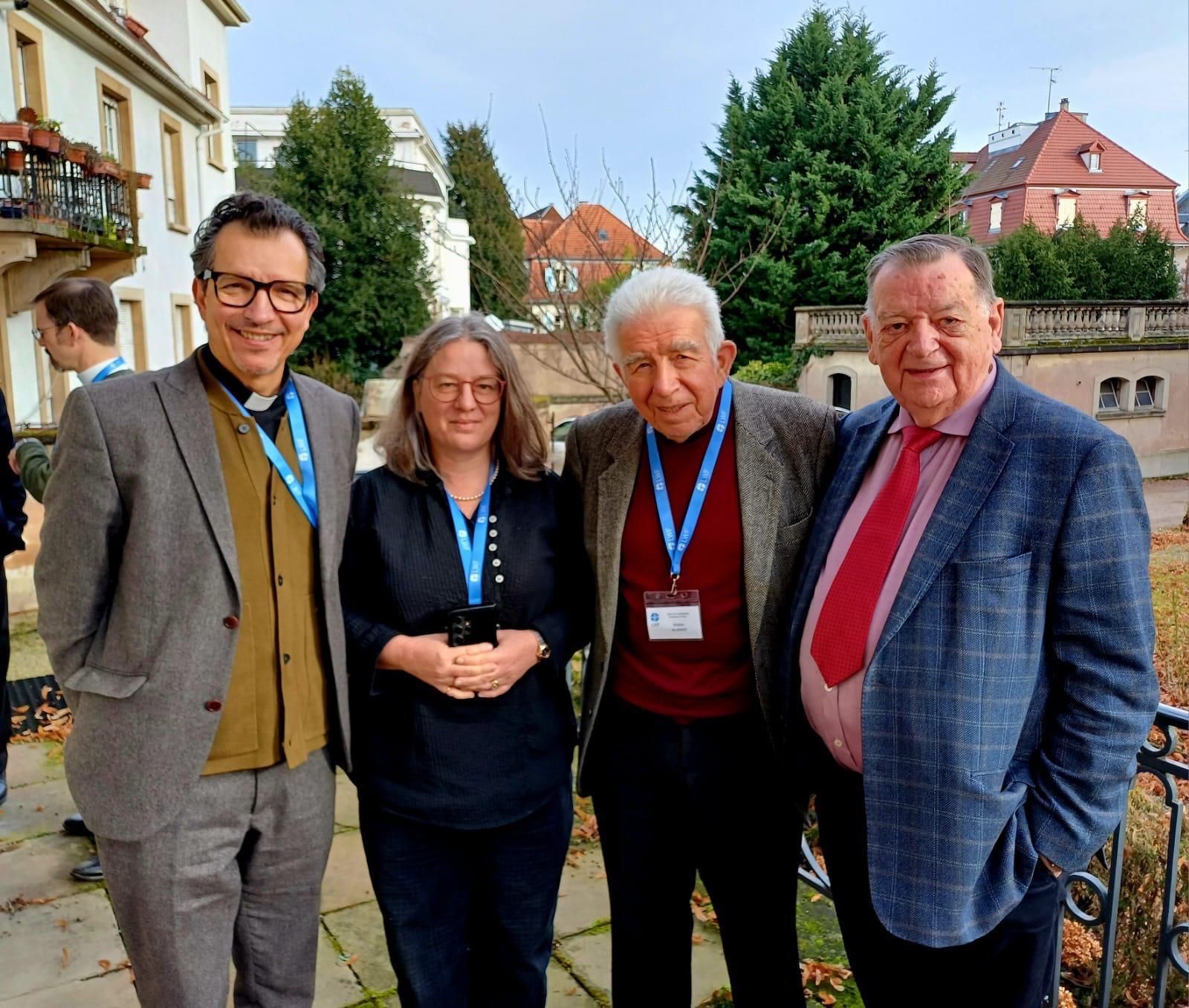
Methodists participants at the JDDJ Conference. Pictured left to right: General Secretary Rev. Dr. Reynaldo Ferreira Leão Neto, Rev. Dr. Jane Leach, Bishop Klaiber and Lord Griffiths (Leslei)

Please send press releases, articles and resources! Submissions should be a page or less (450-500 words), edited and ready to publish. Contact us by Friday, 21 February at communications@worldmethodistcouncil.org if you would like your story to be included in the March edition of the First Friday Letter.
On the Web
This and past First Friday Letters can be found online at FirstFridayLetter.worldmethodistcouncil.org
The World Methodist Council’s website may be found at worldmethodistcouncil.org.
To subscribe to this newsletter, please email communications@worldmethodistcouncil.org.
About the First Friday Letter
The First Friday Newsletter is a monthly publication of the World Methodist Council.
Publisher: Rev. Dr. Reynaldo F. Leão Neto, General Secretary Communications: Michaela Bryson
All stories and photos, unless otherwise stated, are protected by their respective copyrights. Please do not copy without expressed written permission from the Council.
Follow the Council on social media!! Twitter
@WMCouncil
@World Methodist Council @wmcouncil
